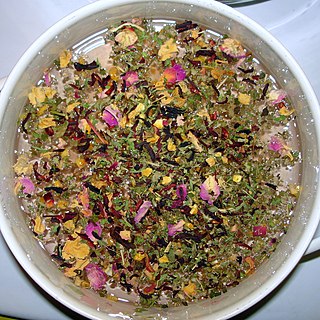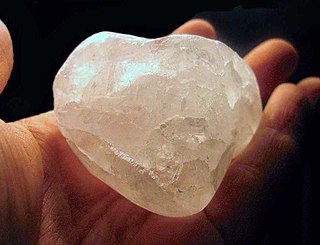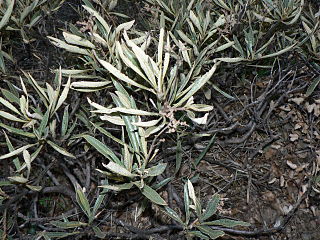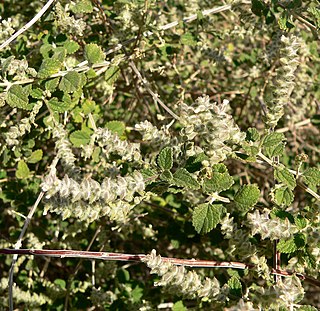
Herbal teas, also known as herbal infusions and less commonly called tisanes, are beverages made from the infusion or decoction of herbs, spices, or other plant material in hot water. Oftentimes herb tea, or the plain term tea, is used as a reference to all sorts of herbal teas. Many herbs are used in herbal medicine. Some herbal blends contain actual tea.

An astringent is a chemical that shrinks or constricts body tissues. The word derives from the Latin adstringere, which means "to bind fast". Calamine lotion, witch hazel, and yerba mansa, a Californian plant, are astringents, as are the powdered leaves of the myrtle.

Encelia farinosa, is a common desert shrub of the southwestern United States and northern Mexico. It has a variety of historical uses.

Ligusticum porteri, also known as oshá, wild parsnip, Porter’s Lovage or wild celery, is a perennial herb found in parts of the Rocky Mountains and northern New Mexico, especially in the southwestern United States.
Porophyllum linaria is a sunny short-lived perennial plant used in Mexican cuisine, where it is often used to flavor meat dishes. It has a strong taste akin to fresh coriander with overtones of lemon and anise.

Calendula officinalis, the pot marigold, common marigold, ruddles, Mary's gold or Scotch marigold, is a flowering plant in the daisy family Asteraceae. It is probably native to southern Europe, though its long history of cultivation makes its precise origin unknown, and it may possibly be of garden origin. It is also widely naturalised farther north in Europe and elsewhere in warm temperate regions of the world.

Chungtia is an Ao Naga village in Nagaland, India. It lies in the Ongpangkong range and is located 16 km north-west of Mokokchung. The Mokokchung-Mariani Highway passes through its eastern corner. It is located at an altitude of 3,362 feet (1,025 m) above sea level.

Eriodictyon is a genus of plants known by the common name yerba santa within the Hydrophylloideae subfamily of the borage family, Boraginaceae. They are distributed throughout the southwestern United States and Mexico.

Prunella vulgaris, the common self-heal, heal-all, woundwort, heart-of-the-earth, carpenter's herb, brownwort or blue curls, is an herbaceous plant in the mint family Lamiaceae.

Rosa californica, the California wildrose, or California rose, is a species of rose native to the U.S. states of California and Oregon and the northern part of Baja California, Mexico. The plant is native to chaparral and woodlands and the Sierra Nevada foothills, and can survive drought, though it grows most abundantly in moist soils near water sources.

Baccharis salicifolia is a blooming shrub native to the sage scrub community and desert southwest of the United States and northern Mexico, as well as parts of South America. Its usual common name is mule fat; it is also called seepwillow or water-wally. This is a large bush with sticky foliage which bears plentiful small, fuzzy, pink or red-tinged white flowers which are highly attractive to butterflies. The long pointed leaves may be toothed and contain three lengthwise veins. It is most common near water sources.

Baccharis sarothroides is a North American species of flowering shrub known by the common names broom baccharis, desertbroom, greasewood, rosin-bush and groundsel in English and "escoba amarga" or "romerillo" in Spanish. This is a spreading, woody shrub usually sticky with glandular secretions along the primarily leafless green stems. The small, thick leaves are a few centimeters long and are absent much of the year, giving the shrub a spindly, twiggy appearance. It flowers abundantly with tiny green blooms on separate male and female plants.

Trixis californica , the American threefold or American trixis, is a species of flowering plant in the family Asteraceae. It is native to the southwestern United States in California, Arizona, New Mexico, and Texas, and in Mexico in the states of Baja California, Chihuahua, Coahuila, Durango, Nuevo León, Sinaloa, Sonora, Tamaulipas, and Zacatecas.

Brickellia californica, known by the common name California brickellbush, is a species of flowering plant in the family Asteraceae.

Aloysia wrightii is a species of flowering plant in the verbena family known by the common names Wright's beebrush and oreganillo. It is native to the Sonoran Desert of southwestern United States and northern Mexico, where it can be found in moist desert canyons, scrub, and woodland habitat. This is a thickly branching shrub which reaches nearly two meters in maximum height and is generally rounded in form. It has small, oval-shaped to nearly round leaves each no more than two centimeters long. The leaves have lightly toothed edges and hairy undersides. The inflorescence is a narrow, woolly spike up to 6 centimeters long, with small, widely spaced white flowers. It is a valuable nectar source for native solitary bees. It is also larval and adult food plant for the rustic sphinx moth (Manduca rustica).

Porophyllum gracile is a species of flowering plant in the family Asteraceae known by the common names odora and slender poreleaf. It is native to northern Mexico and the southwestern United States from California to Texas, where it can be found in rocky and sandy desert scrub habitat.
A. californica may refer to:

Pectis papposa is a species of flowering plant in the family Asteraceae. It is native to North America, where it occurs in the southwestern United States as far east as Texas, and in northern Mexico. Common names include cinchweed, common chinchweed, many-bristle chinchweed, and many-bristle fetid-marigold.
This is a list of plants used by the indigenous people of North America. For lists pertaining specifically to the Cherokee, Iroquois, Navajo, and Zuni, see Cherokee ethnobotany, Iroquois ethnobotany, Navajo ethnobotany, and Zuni ethnobotany.
See also Zuni ethnobotany, and Native American ethnobotany.


















